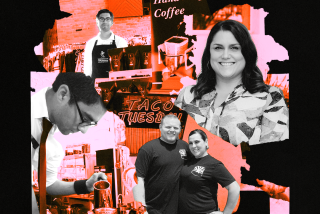Slacker CEO Jim Cady talks streaming music business
With the recent launches of Apple Inc.’s iTunes Radio and Google Play Music All Access, there’s no shortage of options for people who want personalized digital music on demand.
Slacker Inc., which launched its first radio service in 2007, relaunched earlier this year to capture some of the Internet music market. As the name suggests, the company tries to appeal to a more laid-back listener with its pre-programmed stations and computerized radio offering.
Jim Cady, Slacker’s chief executive, may not be the biggest name in the streaming music business, but his San Diego company, which has about 90 employees, is growing. What’s more, he said, it’s making money, thanks to its emphasis on courting paid users, which compose three-quarters of its revenue.
PHOTOS: Hollywood backlot moments
Cady sat down to discuss Slacker’s business model, its deals with mobile carriers and the competition, including fast-growing giant Pandora.
You’ve been with the company since 2006, and there was a bit of a rocky start. How has Slacker’s strategy changed since the early years?
The company’s really gone through a metamorphosis. We were building a radio service that was going to be satellite-delivered. I was brought on board to drive hardware development. We had just finished with all the development stuff in 2008, and we were getting ready to do field tests with a couple automotive companies. Then every car company in the world started to go out of business, and the government had to bail everyone out. It was a really bad time to raise money to go after the car business, so we did a pivot.
We took all the stuff we developed for the music service and used it for a different delivery mechanism. At that point, smartphones looked like the way to go. We started our distribution through Blackberry and migrated to a variety of operating systems.
When Slacker relaunched earlier this year, what changed about the product?
We really wanted to move from the early-adopter space to a more mainstream customer, so we completely redesigned the interface. In addition to that, we took a much higher-level approach in terms of curating content. If you listen to some of the more popular stations on our service, you’ll actually hear on-air personalities. Since we relaunched in the middle of February, we’ve added about 7.5 million new listeners, about two-thirds of them in mobile and a third on the web. It’s also had a good impact on people’s time spent listening. That’s gone up probably 35% in the last 90 days. We’ve moved from obscurity into the top five in just the last few months.
Streaming music is an increasingly competitive business. What makes your service different from Rdio, MOG, Spotify or any of your competitors?
We put listeners in two buckets. The first one is the lean-forward listener, and the other is the lean-back listener. We’re targeting that lean-back customer. I might like jazz, but I might not necessarily want to build a playlist out of it. It’s way too much work. The second thing is adding non-music content, especially in the automotive space. We did a deal for personalized ESPN that you can now mix into your stations if you wish. You can also mix in ABC News and the Weather Channel.
PHOTOS: Celebrities by The Times
A lot of people have talked about the music business moving from an ownership model to an access model, and many have emphasized the importance of music discovery. How does Slacker help users find new music?
We do it in two different ways. We have a machine-driven content algorithm, having to do with popularity and artist relationships. If you like Jack White, you might like the White Stripes and the Raconteurs, because they’re all projects involving the common thread of Jack White. We make connections base on genre, style, artist relationships, etc...
Also, on top of our headcount, we have 80 people that actually curate content every day. For example, Marco Collins, who was the leading grunge DJ in Seattle, programs two stations. You can imagine he probably knows more about grunge than anyone on the planet. The pre-programmed stations are done by those people. Music is keenly emotional, and to turn it all over to the machines is just the wrong way.
Slacker has partnerships with mobile carriers that let subscribers pay through their phone bill with Verizon, Sprint, and so on. How does that help your business?
There’s still a lot of consumer apprehension about entering your credit card information into a smartphone. Also, how many times do you have to type in your credit card number before you get it right? It doesn’t take that many fat-finger mistakes to make you frustrated. We make it a two-touch program, and it just ads to your monthly bill, so it makes it much easier for the consumer to manage. The business advantage for us is the conversion rate is much higher. There’s a big advantage both for the consumer and for us.
You say Slacker is gross-margin positive on every user, paid or unpaid. How?
Our approach was to figure out our model and make sure it works, then spend to ramp the business. We turned the corner probably in January this year. You have two basic models. You have the free ad-driven model, where you’ve got to make the bulk of your money through advertising. And then you’ve got the other side that is primarily paid. We have the vortex of those two.
We have a free service with certain features and restrictions so you can decide whether to pay. If we had only a paid model, I’d have to do all this marketing to get people to try it, and I couldn’t convert at a high enough rate to make money. Seventy-five percent of our revenue comes from subscriptions.
What’s the biggest challenge for Slacker now?
Our biggest challenge to date is we don’t necessarily win the 30-second review, but if you listen to a half-hour, we win. The big challenge for us is making sure we are engaging enough for consumers to spend some time with us. It’s a great time to be a music consumer because there’s a lot of choice.
Pandora has received its fair share of attention for its recent back-and-forth with music industry groups and artists, notably Pink Floyd, over its royalty payments. What’s your take on that situation?
If you look at their business, there are really only a couple of things they can do to be profitable. They can increase the number of ads, get better rates from those ads, or reduce the cost of the music. That’s where they’ve got into a bit of a rub with the artists. I think that’s a non-winning situation.
What’s in the pipeline for Slacker?
A big part of our focus is getting into the car, because that’s where so much content is consumed. We’ve done deals with 12 or 14 car companies now, most of them using smartphones as a kind of modem. We’re also built into the Tesla. It’s crazy the amount of listening people are using it for.
ALSO:
LMFAO, Bruno Mars top ASCAP’s foreign royalties for 2012
Location filming in L.A. up 9% in second quarter thanks to TV
Pharrell sues will.i.am over the phrase ‘i am,’ quotes Dr. Seuss
Follow on Twitter: @rfaughnder
More to Read
From the Oscars to the Emmys.
Get the Envelope newsletter for exclusive awards season coverage, behind-the-scenes stories from the Envelope podcast and columnist Glenn Whipp’s must-read analysis.
You may occasionally receive promotional content from the Los Angeles Times.







